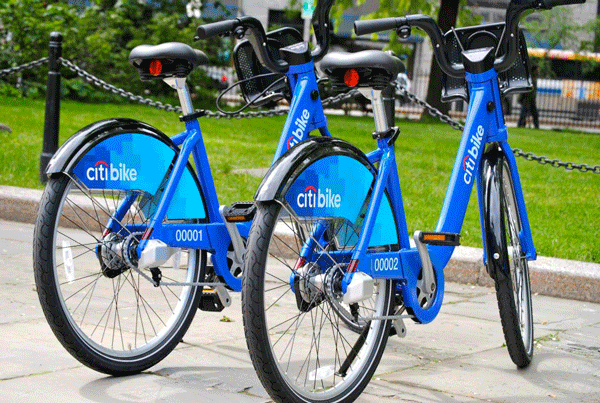
BY LORENZO LIGATO | In a little more than a month, it will be easier for New Yorkers and visitors alike to walk outside and hop on a bicycle.
Citi Bike — the eagerly anticipated bike-sharing program named after lead sponsor Citigroup and operated by New York City Bike Share — will launch at the end of July, when 7,000 bright blue bikes will hit the streets of Manhattan and Brooklyn.
Meanwhile, the city’s Department of Transportation has unveiled the program’s preliminary maps, featuring the first 420 bike station sites. The movable, solar-powered stations will be located along sidewalks, in curbside road space, plazas and other locations suggested by New Yorkers, as part of an extensive community outreach process by D.O.T.
Since September, the department has consulted with local community boards, business groups and property owners in a series of meetings to determine potential bike station sites. In addition, D.O.T. has held more than 30 public events — including presentations, demonstrations, open houses and workshops — to inform citizens about the program, receiving around 70,000 suggestions and comments for station locations on the N.Y.C.
Bike Share Web site, https://a841-tfpweb.nyc.gov/bikeshare/.
“I’m extremely proud to release this plan for the Citi Bike network,” D.O.T. Commissioner Janette Sadik-Khan said in a statement.
“New Yorkers created this plan during the past six months, contributing time and expertise in workshops, online and in dozens of meetings to discuss and plan the city’s newest transportation system,” she said.
The docking stations — which will accommodate between 15 to 60 bikes each — will be installed starting late July in select sites across Manhattan and northern Brooklyn.
More bikes will be placed in key locations, including 149 docks outside Grand Central Station, 177 near Penn Station, 100 around Washington Square Park and 59 outside of Madison Square Garden.
D.O.T. is still selecting bike-station sites for the Upper West and East sides, as well as for Park Slope, Cobble Hill, Prospect Heights and Crown Heights in Brooklyn and Sunnyside in Queens. By next summer, it’s expected that more than 10,000 bikes will be docked at 600 stations across the three boroughs, making New York’s bike-sharing network the nation’s largest.
Damiano DeMonte, a Citi Bike spokesperson, said the city decided to introduce the program to expand transportation options for short-distance trips in the city.
“New Yorkers currently make many such trips each day — 54 percent of all trips made in the city are under 2 miles,” DeMonte said. “Bike-share will give New Yorkers a cheap, easy, efficient and fast option for these trips by providing ready access to a bike, without having to worry about storage or maintenance.”
The bike-share program will be provided at no cost to taxpayers, thanks to a $41 million sponsorship from Citigroup, which fully covers the cost of the equipment. As part of the agreement between the Bloomberg administration and Citigroup, the blue bikes will feature Citigroup’s logo on the frame and on the back-wheel fender.
“From its yellow taxis to its landmark bridges to the Staten Island Ferry, New York is a city of transportation icons, and these signature blue Citi Bikes will be New Yorkers’ newest transportation choice,” Sadik-Khan said.
To access bike-share, individuals can sign up online for a $95 annual membership, entitling them to travel between stations for up to 45 minutes without an additional charge. Daily and weekly passes can also be purchased — for $9.95 and $25, respectively — at Citi Bike station kiosks, but the time limit for rides is 30 minutes. Additional fees are accrued for additional riding time.
“New Yorkers trying to get across town, commuters traveling to or from neighborhoods with fewer subway stations, students getting from dorms to classrooms, people who live a long walk from subway or ferry stations and tourists moving between the city’s vast array of attractions, they will all use the bike-share system,” DeMonte said. He added the program will also extend the reach of the city’s mass transit system into areas that lack adequate subway coverage. Neighborhoods like the Lower East Side and Red Hook spring to mind.
“Ten thousand easily accessible bikes, at reasonable cost, will change New Yorkers heads and habits faster than many think,” said Ellen Jaffe, president of the New York Cycle Club.
Following the example of more than 200 cities across the globe, this program, Jaffe noted, will transform New York City into a more bike- and eco-friendly town.
Cyclists don’t have to wear helmets under the law, and bike-share won’t have helmets for rent. But cyclists can get a free bike helmet by calling 311.

















